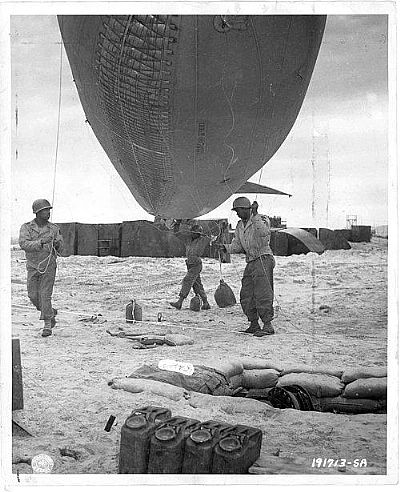320th Barrage Balloon Battalion
In February 1944 a unit of the US Army arrived in Pontypool. They were part of the vast Allied forces assembling for D-Day. This was happening all over Britain, but here the new arrivals were the 320th Barrage Balloon Battalion - one of the Black battalions in the segregated US Army, and the only one to land any men on D-Day itself. Five medics from the Battalion would arrive on Omaha Beach on 6 June 1944. The rest of the Battalion would soon follow. As a Barrage Balloon Battalion their job was to raise helium balloons over the invasion beaches to prevent German aeroplanes from strafing the beaches.
 The photograph, right (US National Archives and Records Administration, courtesy of Linda Hervieux) shows the 320th on Omaha Beach.
The photograph, right (US National Archives and Records Administration, courtesy of Linda Hervieux) shows the 320th on Omaha Beach.
The 621 men of the Battalion were some of 130,000 Black US troops who were stationed in Britain prior to D-Day. The segregated battalions had White officers. These men found a very different country to the one they had come from and very different attitudes - in a surprisingly positive way.
Although the British establishment - including Churchill - objected to the stationing of Black US troops in the UK and even the higher echelons of the US Army wanted them segragated from the White British population, the reaction from ordinary people was quite different.
One member of the 320th who found a welcome in Wales was Wilson Caldwell Monk.
Monk was billeted in the basement of Pontypool's Trinity Methodist Church.
 Monk, of Atlantic City, New Jersey (right, with his wife Mertina, courtesy Linda Hervieux) met the Church's organist, a milkman, Godfrey Prior. Prior invited Monk to join the congregation. Monk also met Prior's wife Jessie. He would come round to the Prior's home in the nearby village of Abersychan for meals. The Prior's own son, Keith was away at the War.
Monk, of Atlantic City, New Jersey (right, with his wife Mertina, courtesy Linda Hervieux) met the Church's organist, a milkman, Godfrey Prior. Prior invited Monk to join the congregation. Monk also met Prior's wife Jessie. He would come round to the Prior's home in the nearby village of Abersychan for meals. The Prior's own son, Keith was away at the War.
Jessie Prior came to see Wilson Monk as a surrogate son. She would eventually write a letter to Monk's real mother, Rosita. It was the start of a correspondence "mother to mother" that would continue after the War was over. Jessie's letter went as follows:
Mrs. Monk, you have a son to treasure, and feel very proud of. We love him very dearly, and will do anything in the world for him, all we regret is we cannot have him home more, but duties won’t allow, he does come as often as possible. We have told him he can look upon our home as his home while in our country, and I will try to fill your place, if only in a small way. But don’t worry too much about him, while he is here, we shall take very every care of him, if ever he is ill, or in any way wanting us, we shall be there, we look upon him now as our own.
Mother to mother,
Very sincerely with loving thoughts,
Jessie Prior xxxxxx
Indeed, soon enough, Wilson Monk and the rest of the 320th would soon be shipping out for the Normandy beaches. The unit would serve there until 24th October 1944, their job done. They would return to the United States for further training before being sent to the Pacific. The unit would, however, not see action again, only getting as far as Hawaii before the War ended.
In the space between his return from Normandy and resumption of training, Wilson would marry Mertina on 6 December 1944. They would remain married for 68 years.
 One of the five medics from the unit was wounded on D-Day, yet kept treating other wounded men before being evacuated himself.
One of the five medics from the unit was wounded on D-Day, yet kept treating other wounded men before being evacuated himself.
His name was Waverly B. Woodson jr (right, courtesy Linda Hervieux).
One US General John Lee recommended Woodson for the highest award, the Congressional Medal of Honor. Instead, Woodson received the Bronze Star, the fourth highest award.
Despite valorous service, no African American soldier in the Second World War was awarded the Medal of Honor.
For more information on the 320th Barrage Balloon Battalion, please view Linda Hervieux's website here. Her book is Forgotten: the untold story of D-Day's black heroes, at home and at war.

